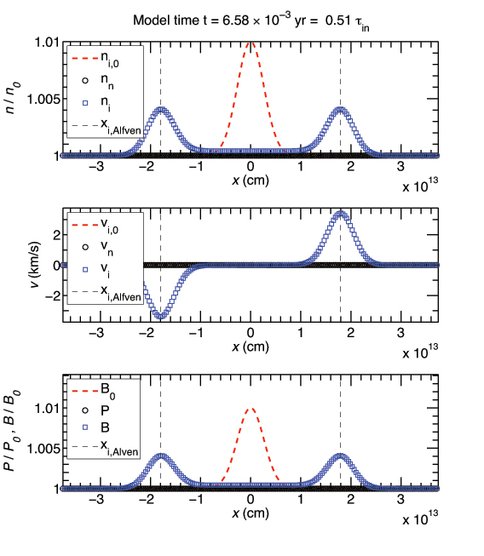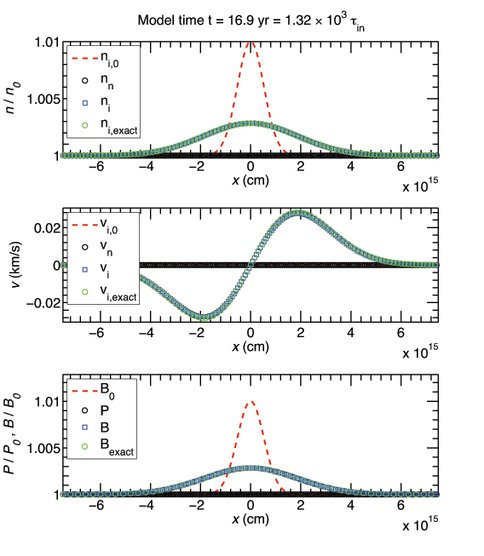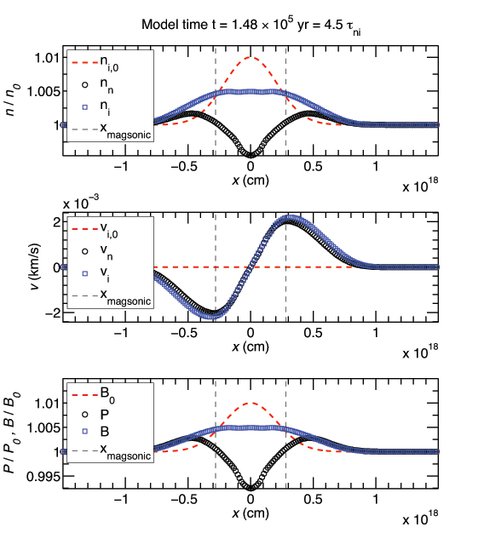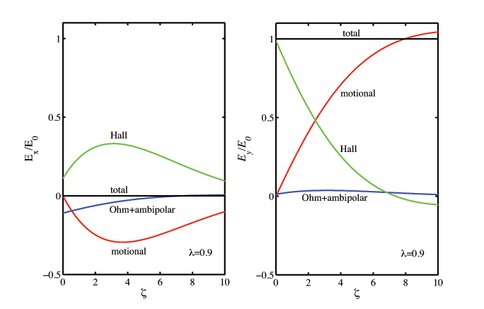2011 Annual Science Report
 Rensselaer Polytechnic Institute
Reporting | SEP 2010 – AUG 2011
Rensselaer Polytechnic Institute
Reporting | SEP 2010 – AUG 2011
Project 2: Processing of Precometary Ices in the Early Solar System
Project Summary
The discovery of numerous planetary systems still in the process of formation gives us a unique opportunity to glimpse how our own solar system may have formed 4.6 billion years ago. Our goal is to test the hypothesis that the building blocks of life were synthesized in space and delivered to the early Earth by comets and asteroids. We use computers to simulate shock waves and other processes that energize the gas and dust in proto-planetary disks and drive physical and chemical processes that would not otherwise occur. Our work seeks specifically to determine (i) whether asteroids and comets were heated to temperatures that favor prebiotic chemistry; and (ii) whether the requisite heating mechanisms operate in other planetary systems forming today.
Project Progress
A. Studies of Multifluid Magnetohydodynamic Shock Waves
Protostars emit hypersonic bipolar jets which generate strong shock waves wherever they impact the surrounding star-forming cloud. This project aims to simulate such shock waves with an emphasis on their molecular line emission. The goal is to facilitate the discovery of prebiotic molecules in space by far-infrared spectroscopy, e.g., using SOFIA. The challenge is that realistic simulations require a time dependent, magnetohydodynamic calculation treating the plasma as three interacting fluids (=neutral gas + ion/electron plasma + dust). We made several advances during the reporting period:
(i) Ciolek and collaborators published an extensive study on wave propagation in multifluid plasmas without dust (Mouschovias et al. 2011).
(ii) Ciolek & Roberge gave a contributed paper on the effects of dust on multifluid MHD waves (Ciolek & Roberge 2011).
(iii) Katz, Ciolek & Roberge gave a contributed paper on driven multifluid waves with dust (Katz, Ciolek & Roberge 2011).
(iv) Roberge and Ciolek published a review article on magnetic fields and the origin and habitability of planetary systems (Roberge & Ciolek 2011).
(v) Ciolek, Gariepy, and Roberge made steady progress on the shock code. Roberge obtained an exact analytic solution for the “multifluid MHD Riemann problem,” a key prerequisite for a broad class of numerical techniques. Gariepy and Roberge researched method of characteristic techniques and ultimately rejected them. Ciolek produced a numerical code for two-fluid (neutral + ion/electon) plasmas based on shock-capturing techniques, an approximate HLLC solver, and the TVD method. Ciolek implemented a parallel-processing version of this code on RPI’s 30,000 node supercomputer. Figures 1-3 describe a benchmark calculation where a weak shock was simulated over 8 decades in time. Comparison with an exact analytic solution shows that the numerical results are accurate to one part in 105 – 106.
B. Electrodynamic Heating of Primitive Solar System Bodies
Roberge and Menzel continued to work on “electrodynamic heating,” a new process for heating asteroids and other primitive bodies. Their objective is to understand (i) whether electrodynamic heating produced thermal environments conducive to prebiotic chemistry in the solar nebula; and (ii) how common such environments would be in other protostellar disks. Because heating by 26Al is unlikely to be important in external disks, this project will set important constraints on the pervasiveness of prebiotic chemistry in protoplanetary environments. The accomplishments for 2010/11 were:
(i) Menzel and Roberge gave a preliminary account of electrodynamic heating in a contributed paper (Menzel & Roberge 2011).
(ii) Roberge and Menzel finished a detailed calculation on the mechanism of electrodynamic heating. The heating is caused by the dissipation of electric currents (Joule heating) inside the asteroid material. The electric fields which drive these currents are generated in a multifluid shear flow at the asteroid-plasma interface (Fig. 4) via the tendency of shearing motions, ambipolar diffusion, the Hall effect, and Ohmic dissipation to produce magnetic field gradients and hence electrical fields (Fig. 5). Significant heating was found to require supersonic shear flow, which may be associated with bipolar outflows, shock waves, or hydrodynamic escape of the disk plasma. A paper reporting the results of the calculation is in preparation.
Number densities (top), velocities (middle), and pressures (bottom) plotted vs position x, where the subscripts denote properties of the neutral (n) and ion-electron (i) fluids. In the bottom panel P/P_0 and B/B_0 denote the neutral thermal pressure and magnetic field normalized to their initial values. The initial conditions are a static state with Gaussian pulses in the pressure and density (dashed red lines). The symbols are numerical results at the very early time indicated at the top.
Same as Fig. 1 but for time t=16.9 yr.
Same as Fig. 2 but for time t=1.48 × 10^5 yr.
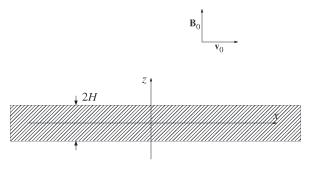
Electrodynamic heating is caused by shear flows near the surfaces of asteroids and other primitive bodies. We model the bodies as rectangular prisms. In the undisturbed flow at large z the plasma moves at the free streaming velocity v_0 in the x direction. The undisturbed magnetic field B_0 is in the z direction. Close to the surface, various effects in the shear layer distort the magnetic field, producing induced electric fields that penetrate and heat the asteroid.
The electric field in the shear layer is the sum of a motional field (red) plus fields produced by the Hall effect (green), and the combined effects of Ohmic dissipation plus ambipolar diffusion (blue). The total field (black) is also indicated. Field contributions are plotted vs altitude z above the asteroid surface, both in arbitrary units.
Publications
-
Mouschovias, T. C., Ciolek, G. E., & Morton, S. A. (2011). Hydromagnetic waves in weakly-ionized media – I. Basic theory, and application to interstellar molecular clouds. Monthly Notices of the Royal Astronomical Society, 415(2), 1751–1782. doi:10.1111/j.1365-2966.2011.18817.x
- Ciolek, G.E. & Roberge, W.G. (2011). Hydromagnetic Signal Speeds In Weakly Ionized, Dusty Interstellar Clouds Having A Spectrum Of Grain Radii. Bulletin of the American Astronomical Society, 43(251.01).
- Katz, M.P., Ciolek, G.E. & Roberge, W.G. (2011). Driven Hydromagnetic Waves and Shocks in Dusty Interstellar Clouds. Bulletin of the American Astronomical Society, 43(251.03).
- Menzel, R.L. & Roberge, W.G. (2011). Induction Heating of Planetesimals in Protoplanetary Disks. Bulletin of the American Astronomical Society, 43(339.07).
- Roberge, W.G. & Ciolek, G.E. (2011). Magnetic Fields, Stars, and Planetary Systems Formation. Encyclopedia of Astrobiology. Vol. 13.
- Roberge, W.G. & Menzel, R.L. (2011, In Preparation). Electrodynamic Heating of Primitive Solar System Bodies. ApJ.
-
PROJECT INVESTIGATORS:
-
PROJECT MEMBERS:
Glenn Ciolek
Research Staff
Max Katz
Graduate Student
Raymond Menzel
Graduate Student
Allycia Gariepy
Undergraduate Student
Nick Senno
Undergraduate Student
Aaron Smith
Undergraduate Student
-
RELATED OBJECTIVES:
Objective 1.1
Formation and evolution of habitable planets.
Objective 3.1
Sources of prebiotic materials and catalysts
Objective 3.2
Origins and evolution of functional biomolecules
